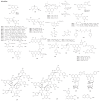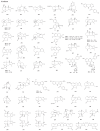Chemical constituents and bioactivity of Formosan lauraceous plants
- PMID: 28911577
- PMCID: PMC9339549
- DOI: 10.1016/j.jfda.2015.10.008
Chemical constituents and bioactivity of Formosan lauraceous plants
Abstract
Taiwan is rich in lauraceous plants. A review of 197 references based on the chemical analysis and bioactivity of indigenous lauraceous plants carried out by native scientists from 1963 to 2014 has been compiled. About 303 new compounds and thousands of known compounds comprising alkaloids and non-alkaloids with diverse structures have been isolated or identified from indigenous plants belonging to the 11 lauraceous genera. The volatile components, however, have been excluded from this review. This review provides an overview of the past efforts of Taiwan scientists working on secondary metabolites and their bioactivity in native lauraceous plants. The potential of lauraceous plants worthy of further study is also noted. The contents will be helpful for the chemotaxonomy of Lauraceae and be of value for the development of native Formosan lauraceous plants.
Keywords: Bioactivity; Chemical constituents; Lauraceae; Review; Taiwan.
Copyright © 2016. Published by Elsevier B.V.
Figures








Similar articles
-
[Studies on the alkaloids of Formosan Lauraceous plants. XI. Alkaloids of Litsea cubeba Persoon. 2].Yakugaku Zasshi. 1967 Jul;87(7):878-9. doi: 10.1248/yakushi1947.87.7_878. Yakugaku Zasshi. 1967. PMID: 5625825 Japanese. No abstract available.
-
[Studies on the alkaloids of formosan lauraceous plants. XIV. Alkaloids of Actinodaphne acutivena (hayata) Nakai and Litsea hayatae Kanehira].Yakugaku Zasshi. 1969 Sep;89(9):1313-6. doi: 10.1248/yakushi1947.89.9_1313. Yakugaku Zasshi. 1969. PMID: 5388640 Japanese. No abstract available.
-
[Studies on the alkaloids of Formosan lauraceous plants. 13. Alkaloids of Notaphoebe Komishii Hayata].Yakugaku Zasshi. 1967 Oct;87(10):1282-4. doi: 10.1248/yakushi1947.87.10_1282. Yakugaku Zasshi. 1967. PMID: 5627002 Japanese. No abstract available.
-
Alkaloids of the Lauraceae.Alkaloids Chem Biol. 2019;82:147-304. doi: 10.1016/bs.alkal.2018.11.002. Epub 2019 Feb 26. Alkaloids Chem Biol. 2019. PMID: 30850031 Review.
-
Endiandric Acid Derivatives and Other Constituents of Plants from the Genera Beilschmiedia and Endiandra (Lauraceae).Biomolecules. 2015;5(2):910-42. doi: 10.3390/biom5020910. Biomolecules. 2015. PMID: 26117852 Free PMC article. Review.
Cited by
-
Chemical Constituent of β-Glucuronidase Inhibitors from the Root of Neolitsea acuminatissima.Molecules. 2020 Nov 6;25(21):5170. doi: 10.3390/molecules25215170. Molecules. 2020. PMID: 33172041 Free PMC article.
-
Anti-Inflammatory and Antibacterial Activity Constituents from the Stem of Cinnamomum validinerve.Molecules. 2020 Jul 25;25(15):3382. doi: 10.3390/molecules25153382. Molecules. 2020. PMID: 32722482 Free PMC article.
-
Immunomodulatory Effects of Taiwanese Neolitsea Species on Th1 and Th2 Functionality.J Immunol Res. 2017;2017:3529859. doi: 10.1155/2017/3529859. Epub 2017 Jul 11. J Immunol Res. 2017. PMID: 28781969 Free PMC article.
-
Phytochemical Investigation and Anti-Inflammatory Activity of the Leaves of Machilus japonica var. kusanoi.Molecules. 2020 Sep 10;25(18):4149. doi: 10.3390/molecules25184149. Molecules. 2020. PMID: 32927887 Free PMC article.
-
Anti-inflammatory effect of cinnamaldehyde and linalool from the leaf essential oil of Cinnamomum osmophloeum Kanehira in endotoxin-induced mice.J Food Drug Anal. 2018 Jan;26(1):211-220. doi: 10.1016/j.jfda.2017.03.006. Epub 2017 Apr 19. J Food Drug Anal. 2018. PMID: 29389558 Free PMC article.
References
-
- Liao JC. Lauraceae in Flora of Taiwan. 2nd ed. Vol. 2. Taipei: Editorial Committee of the Flora of Taiwan; 1996. pp. 433–99.
-
- Wu YC, Liou YF, Lu ST. Antimicrobial activity of isoquinoline alkaloids and their N-oxide derivatives. Kaohsiung J Med Sci. 1988;4:336–44. - PubMed
-
- Tsai IL, Liou YF, Lu ST. Screening of isoquinoline alkaloids and their derivatives for antibacterial and antifungal activities. Kaohsiung J Med Sci. 1989;5:132–45. - PubMed
-
- Kuo YH, Lin YT. Natural research in Taiwan (I) Sci Dev. 1986;14:1223–52.
-
- Kuo YH. Natural research in Taiwan (II) Kaohsiung J Med Sci. 1989;5:360–88. - PubMed
Publication types
MeSH terms
Substances
LinkOut - more resources
Full Text Sources
Other Literature Sources
Miscellaneous
